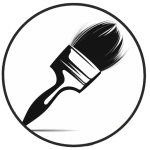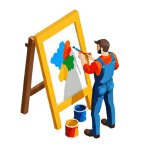Welcome Painters! Learn How to Paint Like a Pro
Introduction: The Importance of Paint Cleanup
Welcome to this self-guided online lesson on how to paint. Whether you're a seasoned painter or just starting out, mastering the art of painting involves more than just the brushstrokes. One crucial aspect of the painting process that is often overlooked is paint cleanup. Properly cleaning up after painting not only maintains the longevity of your tools but also ensures a clean and organized workspace for your next project.
In this lesson, we will explore the significance of paint cleanup and provide you with practical solutions to help streamline this essential part of the painting process. By following our step-by-step guide, you'll be able to achieve professional results and make your painting experience more efficient and enjoyable.
So, let's dive in and discover the best practices for paint cleanup that will elevate your painting skills to the next level!
Proper paint cleanup is essential to maintain the quality of your painting tools and to ensure a neat and tidy work environment. By following the right techniques, you can make the cleanup process efficient and hassle-free. Here are some key steps to help you achieve successful paint cleanup:
1. Remove Excess Paint: Before starting the cleanup process, use a rag or paper towel to remove excess paint from your brushes, rollers, and other tools. This will prevent paint from drying on the tools and make them easier to clean.
2. Use the Right Cleaning Agents: Depending on the type of paint you are using, choose the appropriate cleaning agent. For water-based paints, soap and water are usually sufficient. For oil-based paints, you may need mineral spirits or paint thinner.
3. Clean Tools Immediately: After you have finished painting, clean your tools immediately to prevent the paint from drying on them. Follow the manufacturer's instructions for cleaning specific tools, such as brushes and rollers.
4. Dispose of Waste Properly: Dispose of paint waste, such as leftover paint and cleaning agents, according to local regulations. Avoid pouring paint or cleaning agents down the drain, as they can harm the environment.
5. Protect Your Work Area: Lay down drop cloths or newspapers to protect your work area from any spills or splatters during the cleanup process. This will make cleaning up easier and prevent damage to your floors or furniture.
By following these proper paint cleanup techniques, you can maintain your painting tools, keep your work area clean, and ensure a successful painting project from start to finish.
Once you have completed your painting project, it's important to gather the necessary supplies for a thorough cleanup. Having the right tools on hand will make the process quicker and more efficient. Here are the supplies you will need:
1. Drop Cloths or Plastic Sheets: Lay down drop cloths or plastic sheets to protect your floors and furniture from any drips or spills during cleanup.
2. Rags or Paper Towels: Have plenty of rags or paper towels available to wipe up any excess paint and clean your brushes and other tools.
3. Paint Thinner or Solvent: If you are using oil-based paints, you will need paint thinner or solvent to clean your brushes properly.
4. Bucket or Container: Use a bucket or container to hold your cleaning solution for brushes and other painting tools.
5. Soap and Water: For water-based paints, have soap and water ready to clean your brushes and hands.
6. Gloves: Protect your hands by wearing gloves during cleanup to avoid direct contact with paint and cleaning chemicals.
7. Trash Bags: Use trash bags to dispose of any used rags, paper towels, and other disposable items used during cleanup.
Having these supplies gathered and organized before you start cleanup will help make the process smoother and ensure that your painting tools are properly cleaned and maintained for future use.
To ensure that your paint tools and materials last longer and remain in good condition, proper cleaning after each painting session is essential. Follow these step-by-step instructions for cleaning your paint tools and materials:
1. Brushes: Start by removing excess paint from the brush by wiping it on a rag or paper towel. Then, dip the brush in warm, soapy water and gently swirl it around to loosen any remaining paint. Rinse the brush thoroughly under running water until the water runs clear. Finally, reshape the bristles and let the brush air dry.
2. Rollers: Remove the roller from the roller frame and rinse it under running water. Use a roller cleaner tool to remove any excess paint stuck in the roller. Once clean, let the roller air dry before storing it.
3. Paint Trays: Scrape off any excess paint from the paint tray using a putty knife or scraper. Wash the tray with warm, soapy water, scrubbing off any dried paint. Rinse the tray thoroughly and let it air dry.
4. Drop Cloths or Tarps: Shake off any dried paint on the drop cloth or tarp outside. If there are any wet paint spills, use a cloth soaked in soapy water to clean the area. Hang the drop cloth or tarp to dry completely before storing.
By following these simple steps, you can maintain your paint tools and materials in good condition for future use.
Efficient and effective paint cleanup is essential to maintain your painting tools and workspace. Follow these tips to make the cleanup process easier:
1. Use Drop Cloths: Before starting any painting project, cover the floors and furniture with drop cloths to protect them from paint splatters and spills. This will significantly reduce the cleanup time and effort required.
2. Clean Tools Immediately: After painting, clean your brushes, rollers, and trays immediately to prevent the paint from drying on them. Use warm, soapy water for water-based paints and paint thinner for oil-based paints.
3. Store Paint Properly: Seal paint cans tightly after use to prevent them from drying out. Store them in a cool, dry place away from direct sunlight.
4. Use Disposable Items: Consider using disposable paint tray liners and brushes to minimize cleanup. Simply throw them away after use.
5. Clean Up Spills Promptly: Accidents happen, so it's crucial to clean up any spills or drips immediately to prevent them from spreading and causing more mess.
6. Use Painter's Tape: Painter's tape can help create clean lines and edges while painting. Remove the tape carefully after painting to avoid peeling off any fresh paint and creating a cleanup nightmare.
7. Dispose of Paint Properly: Follow local guidelines for disposing of leftover paint and paint cans. Do not pour paint down the drain as it can harm the environment.
After completing your painting project, it is essential to conduct a final check to ensure everything is in order before moving on to the cleanup process. Begin by inspecting the painted surface for any missed spots, drips, or imperfections. Touch up any areas that require additional paint to achieve a consistent and flawless finish.
Once you are satisfied with the painted surface, shift your focus to the workspace cleanup. Start by organizing your painting materials and storing them properly to prevent any spills or accidents. Dispose of any used paint cans, brushes, or other disposable items in the designated waste containers.
Next, clean your painting tools thoroughly to maintain their longevity and ensure they are ready for future use. Rinse brushes and rollers with water or the appropriate cleaning solution, depending on the type of paint used. Wipe down any paint trays, buckets, or other equipment to remove excess paint residue.
Finally, take a moment to tidy up the entire workspace. Sweep the floor to remove any paint chips, dust, or debris that may have accumulated during the painting process. Wipe down any surfaces that came in contact with paint to restore the area to its original condition.
Remember the Importance of Paint Cleanup for an Easy Process
As you conclude this lesson on painters in our HOW TO PAINT series, it is crucial to emphasize the significance of achieving the goal of paint cleanup. Ensuring a clean workspace not only facilitates an easy painting process but also helps maintain the longevity of your painting tools and surfaces.
Review and Apply
If you find yourself needing a refresher on the best practices for paint cleanup, don't hesitate to revisit this lesson. Additionally, make use of the other valuable lessons in this course to enhance your painting skills and techniques.
By prioritizing paint cleanup and incorporating the tips covered in this lesson, you are one step closer to achieving a seamless and enjoyable painting experience. Remember, a clean workspace leads to a smooth process and beautiful results!
Lesson Audio

